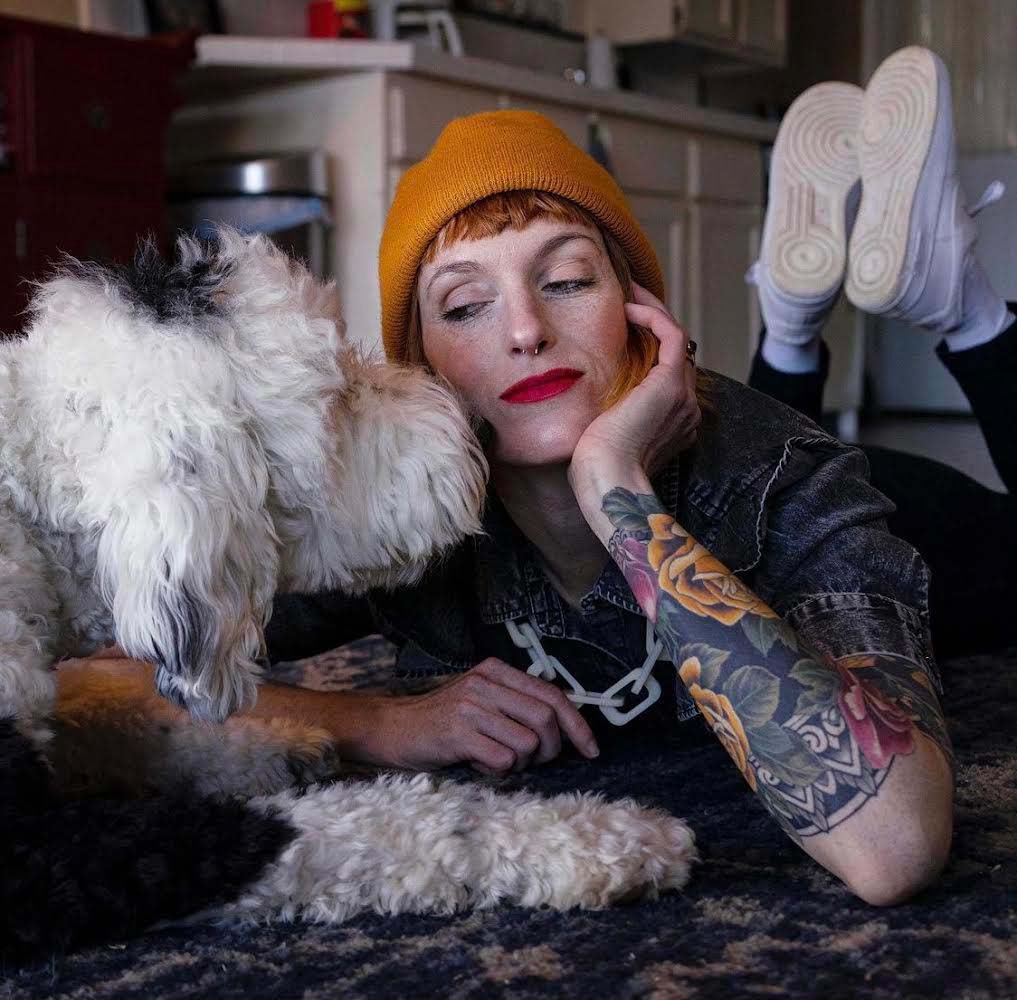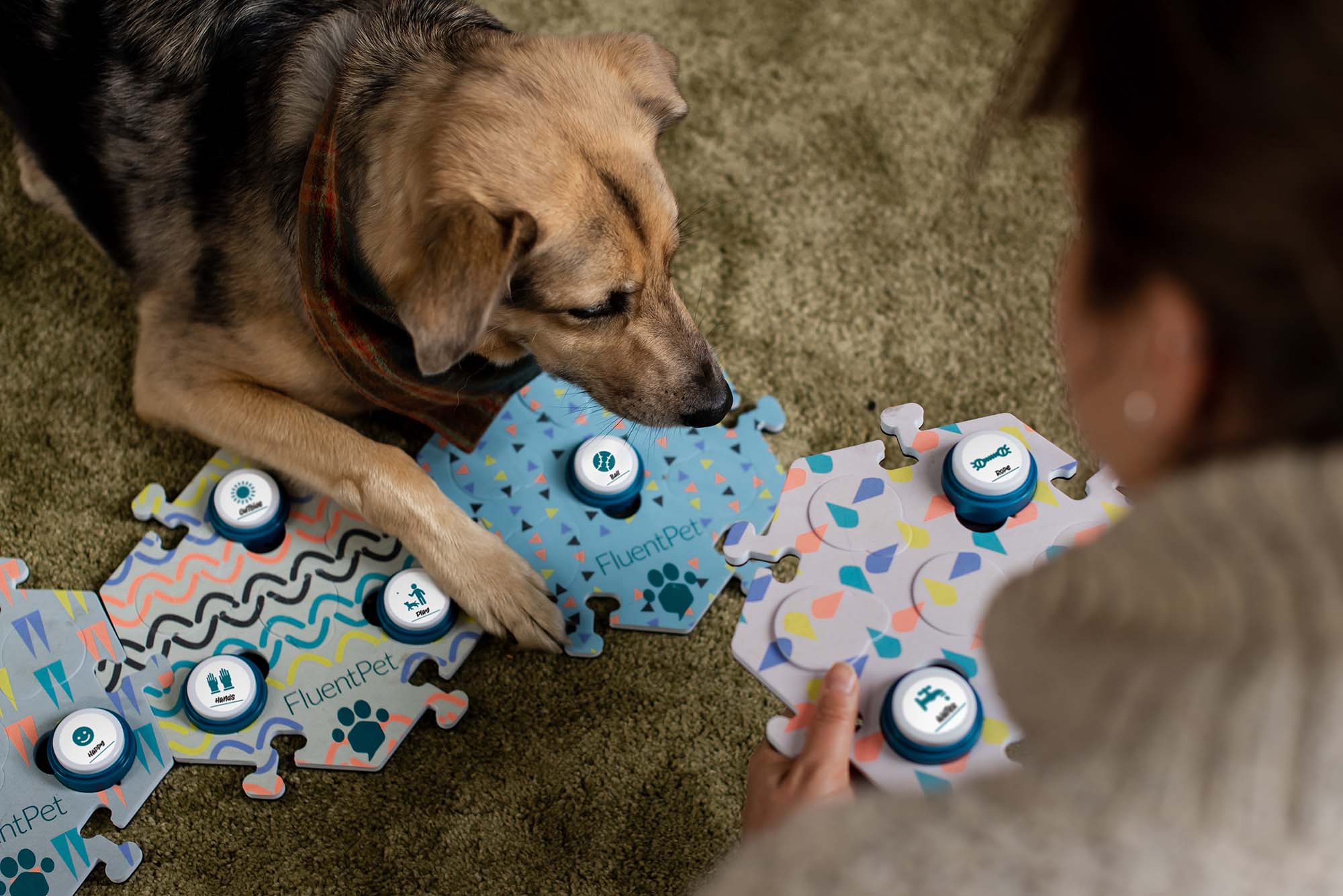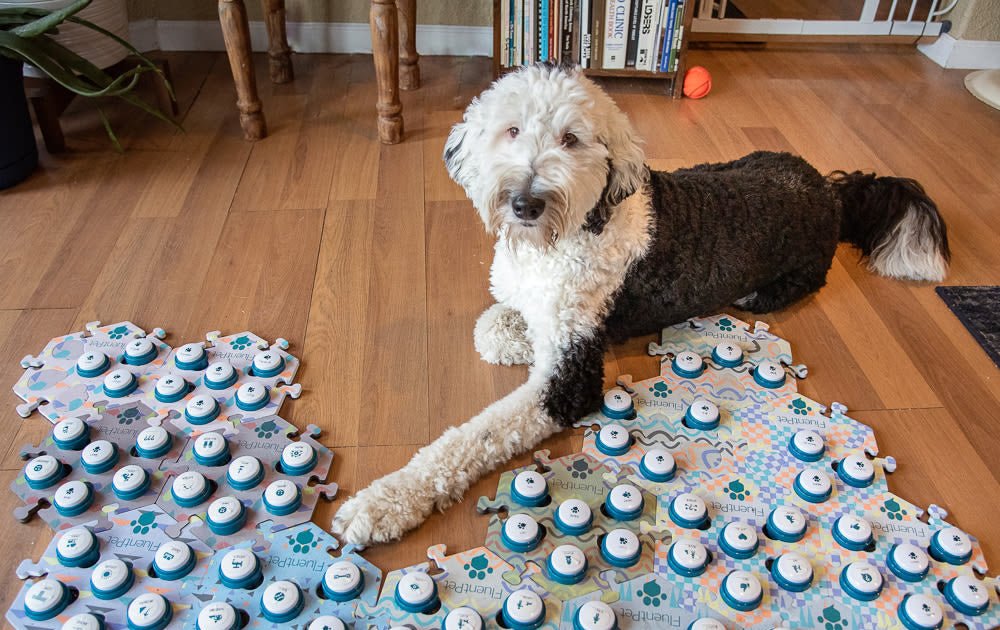Alexis Devine, or @whataboutbunny on Instagram, calls in from Tacoma, Washington at nine in the morning. With her yellow Carhartt beanie and copper hair, she’s a spot of sunlight in an otherwise overcast February. Bunny’s nowhere to be seen—until our conversation is interrupted by Bunny’s surprisingly loud roo roos (as Alexis calls them). Alexis pans her camera to show us the black-and-white sheepadoodle barking at the window. “It’s just Dad, Buns!” Alexis exclaims, and Bunny seems to understand. Bunny shakes off as she walks past the camera—I’m told this is a self-regulating behavior indicating a personal “reset” by Ashley, who’s one of the researchers attending the call.

Now at two and a half years old, Bunny is considered to be mature. This much is obvious by the presence of her poodle sibling, Otter, who’s eight months old and in the throes of dog adolescence. “He’s like a chaos demon,” Alexis says as Otter noses his way into the camera. “Him and Bunny are going to be super chill together when they’re older, but right now he’s a terrorist.” Alexis laughs and Otter trots offscreen again.
We talk about how Bunny’s vocabulary has changed over the course of the past year—Bunny is now at an astounding 102 words. These days, Alexis has become much more intentional with adding new words to the soundboard. “We’ve been introducing them more slowly. We’ve added a ton since this time last year, but in the past six months, we’ve only really added one or two words.” The latest words include BELLY, OTHER, WORD, and FEEL.
These words seem so abstract to me that I can’t help feeling impressed—Alexis tells me she added OTHER WORD in hopes that “if Bunny is trying to communicate something and I’m guessing at what she’s trying to say, she could use the word OTHER to tell me that I’m not right instead of immediately getting frustrated.” I ask if Bunny has used OTHER in this context before and Alexis says she has, but that it can still be confusing. “It’s hard because I’ll guess a word that’s on the board, and if it’s not a word she’s already familiar with, then it’s hard to know.”
Alexis is thinking about adding the word BORED next—offering yet another option for Bunny to express her displeasure.
When I ask Alexis why she’s become more intentional with adding new words, she mentions that, even for herself, differentiating the locations of 102 words on the board can get a little tricky. The bizarreness of the conversation we’re having really sinks in and Alexis grins. “This sounds really funny now that I’m saying it out loud, but it’s awkward if you’re trying to have a ‘conversation’ with your dog and you can’t find the words you need.”
I glance at a picture of Bunny’s board and have to agree—the board’s bigger than Bunny herself. “It’s one of the reasons why I’m excited now that FluentPet has the solid-colored tiles that appeal to how dogs perceive color,” Alexis says. “It’ll make it a lot easier for her to understand groupings and remember where individual buttons are.”
Alexis also gives excellent advice for teachers when it comes to modeling, or showing your learner how to use the buttons.
“It’s important for the teacher to be well-versed on the word locations—not only for the words that are of high value to your learner, but also the words that are used less. If you want them to be used more frequently, they have to be used more by you.”
When our conversation turns to other developments in Bunny’s (and Alexis’) life, Alexis brings up the biggest change for both of them: the arrival of a new dog five months ago. Here, Ashley steps in to commend Alexis on how well Otter was introduced to the household (keeping the two dogs separated but in the same living space was a vital part of the early process).
“It was important for us to set the stage for positive lifelong interactions,” Alexis says. “At first, it was overwhelming to Bunny, and she didn’t use the buttons much at all. But as they acclimated to each other, they developed a sweet, if sort of sibling rivalry-esque, relationship. She's using the buttons more again and as Otter has grown bolder in the environment, he interrupts her with his own buttons. So that's been a huge change in how she uses them.”
Bunny isn’t alone in this behavioral shift. Many of our learners tend to use their buttons less when they’re adjusting to new situations. However, the majority bounce back—and Bunny’s no exception, even though Otter can still be a bit of a distraction.

All of us laugh when Alexis recounts Bunny's early reactions to Otter. “Shortly after we brought Otter home, there was a lot of WHY and UGH. Like, hello, WHY is he running around like a Tasmanian devil? WHY is he humping a pillow?”
But like between all siblings, there’s a reluctant love underneath that indignation. “Bunny finally started letting Otter be ‘predator’ while they play. She’ll roll over and put her legs up and he'll chew on her neck and growl. It's really sweet—it means she trusts him. Especially as a reactive dog, to put herself in a vulnerable position was huge. Now that's the way they always play, she's like you wanna play?—” Alexis tilts her head and mimics flopping over “—bite my neck.”
I ask Alexis if she’s noticed herself paying more attention to her dogs’ body language. Buttons are one way to communicate, but dogs also naturally express nonverbal signals with their body. Alexis is thrilled with this question. Apparently, the study of applied canine ethology, or the science of dog behavior, has become her special interest.
“I’m on a learning journey right now—it’s like I’m in school, I spend four to five hours a day studying. I have like twenty courses open in my browser right now, and I’m completely overwhelmed by them. It’s wonderful.”
We discuss some behaviors Alexis has learned to look out for: “lip licks and whale-eye, where her eye is toward the trigger and her head is away so you see the whites—both stress signals. We always love to see loose, floppy body language…I’m constantly analyzing her behavior.” Bunny interrupts our chat to offer some doggy kisses, and at Alexis’ redirection, settles beside her for the remainder of the call.
Alexis speaks with such animation about applied ethology that I find myself swept up in the topic as well—with Ashley’s input, we talk dog behavior for some time. Alexis even goes to dog parks alone to observe how other dogs play to better understand their behavior.
She goes on to mention how stressful things were when Bunny was younger. “Having a reactive dog is very challenging and even a little traumatic for a number of reasons––like feeling guilty that it’s your fault, which it’s usually not.” Bunny has always been somewhat anxious even as a puppy, and she was also Alexis’ first dog. As a result, Alexis has spent much time learning how to advocate for Bunny’s best interests, whether that’s through managing a stress-free environment for Bunny, self-studying, or taking a professional course online.
It’s evident that Alexis’ bond with Bunny runs much deeper than a shared interest in button communication—Alexis invests hours in learning Bunny’s language as much as Bunny learns hers. Communication is a two-way street that requires equal parts listening and speaking, and it’s apparent Alexis and Bunny have a genuine, underlying desire to understand one another. The respect and adoration Alexis holds for Bunny is positively overflowing.
I once again have the impression that @whataboutbunny’s success and virality does not derive only from the abilities of a clever sheepadoodle. At the end of the day, it’s the immutable companionship and love between human and dog that moves us, a story as old as time.





3 comments
Leave a comment
This site is protected by hCaptcha and the hCaptcha Privacy Policy and Terms of Service apply.